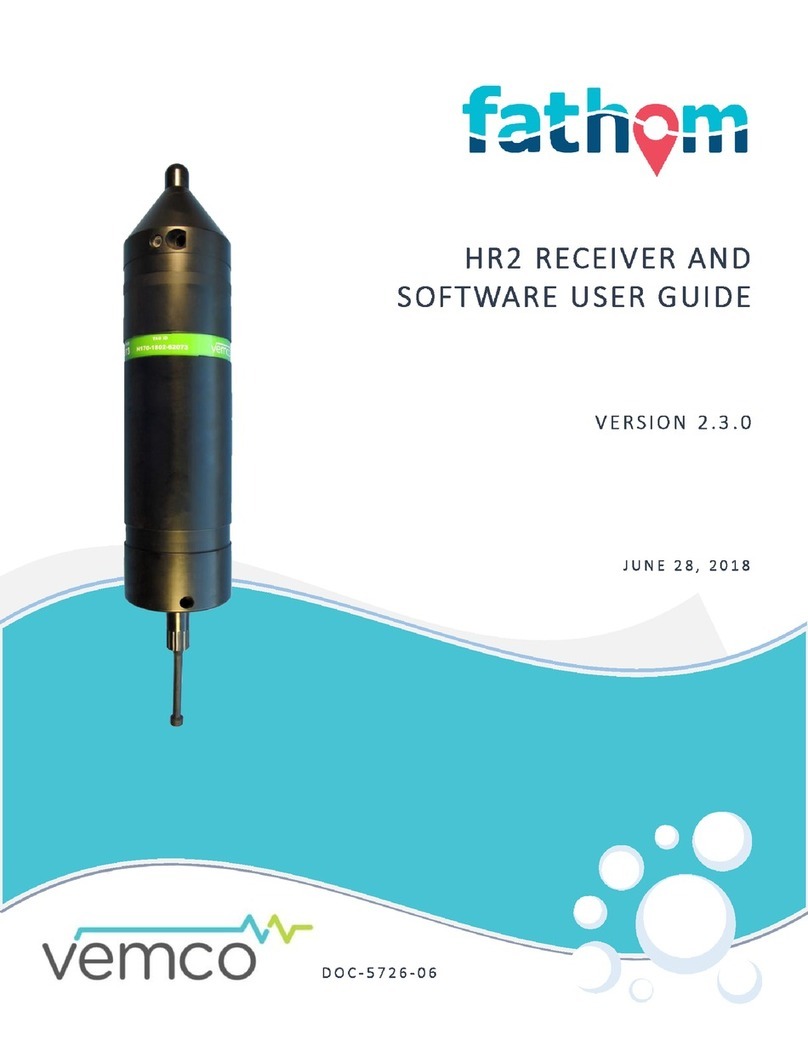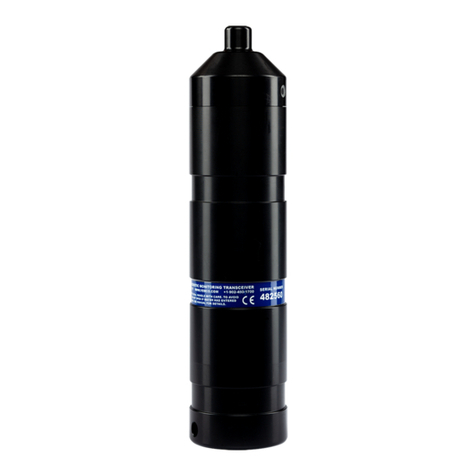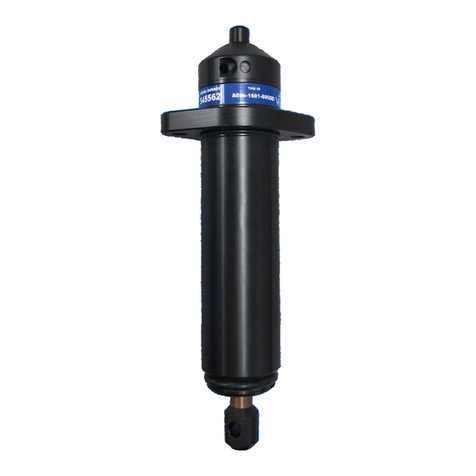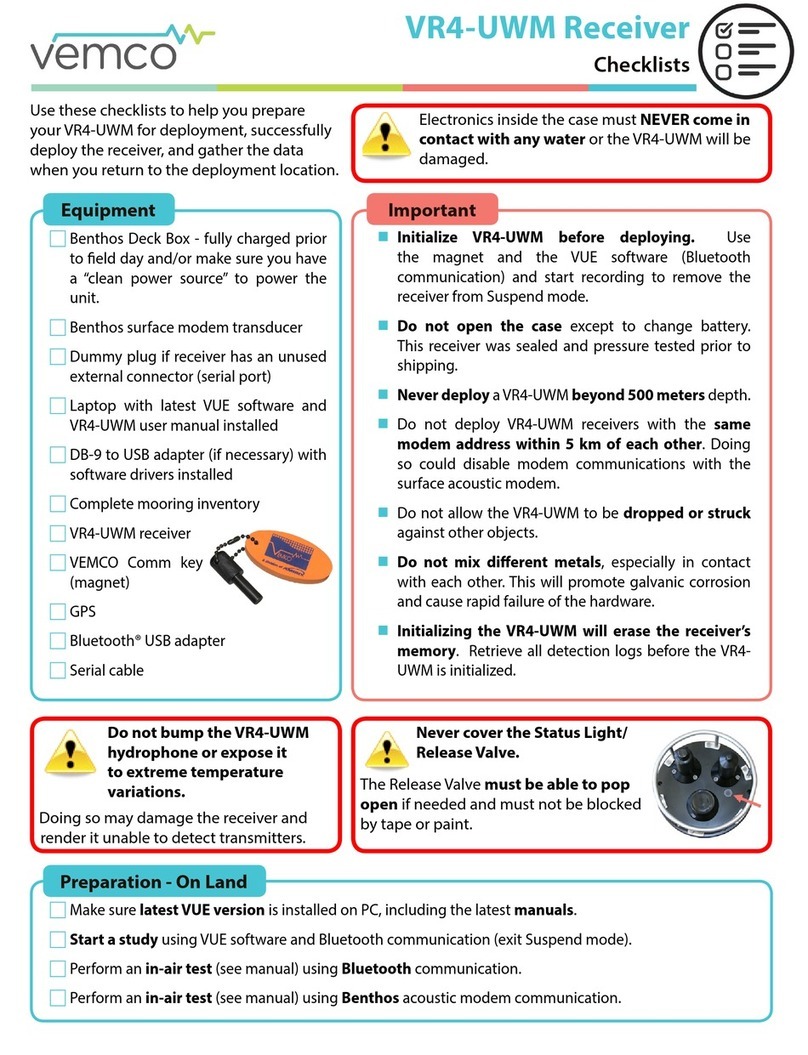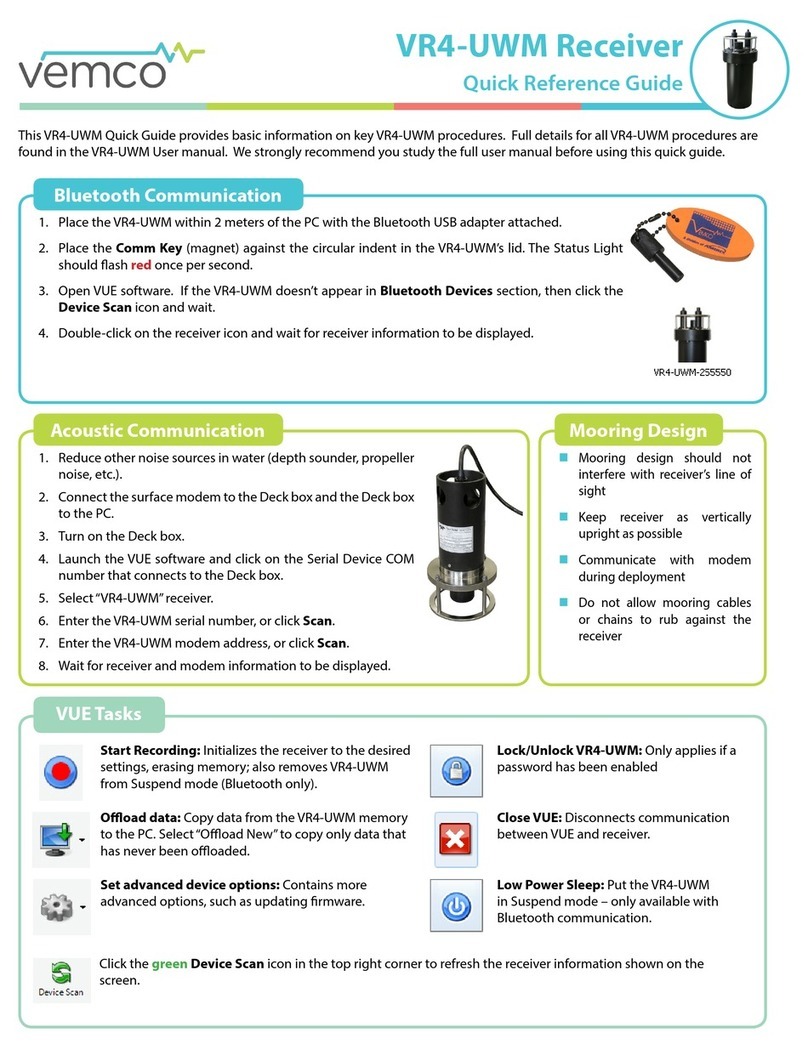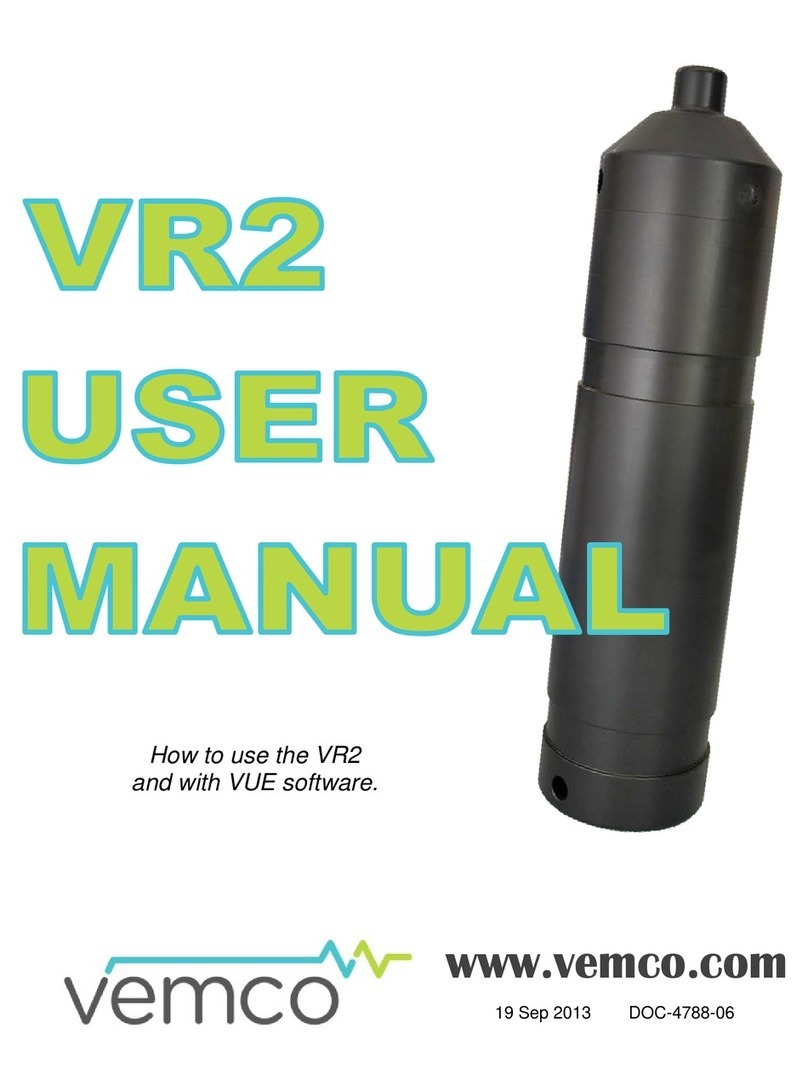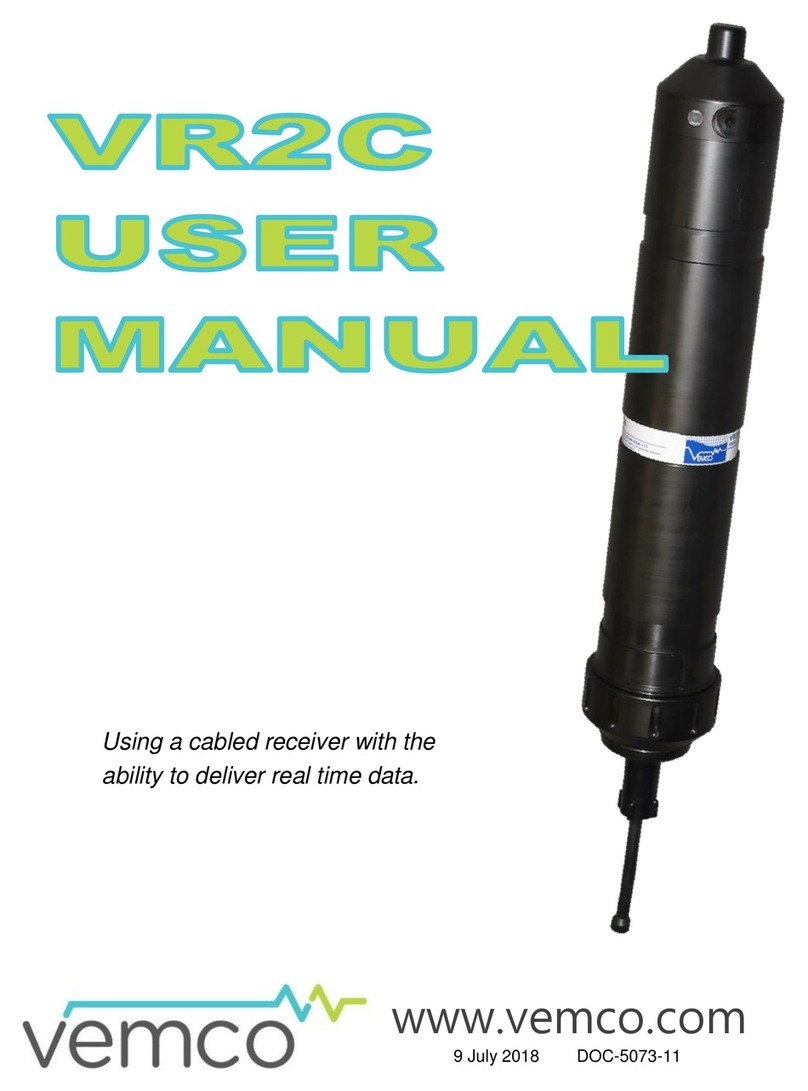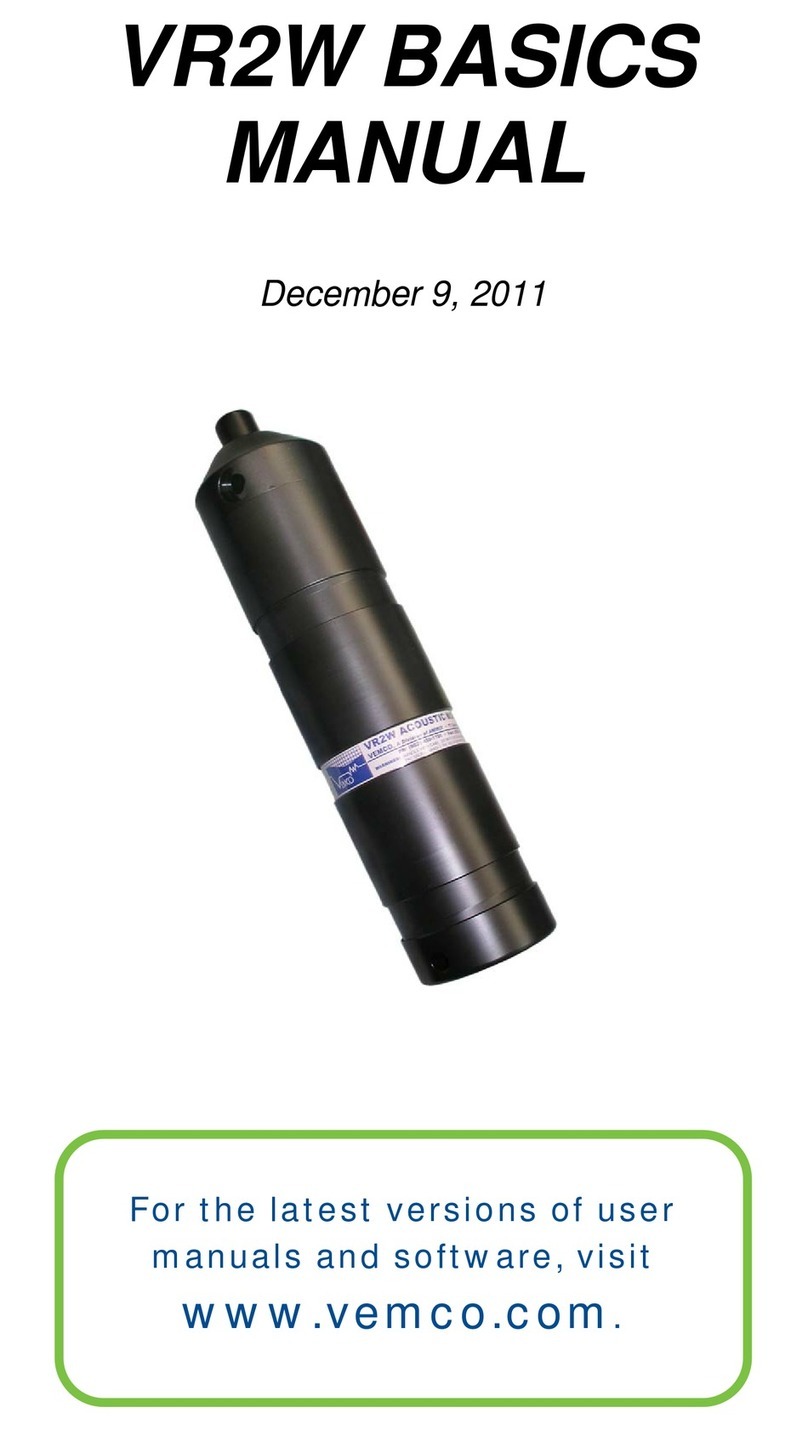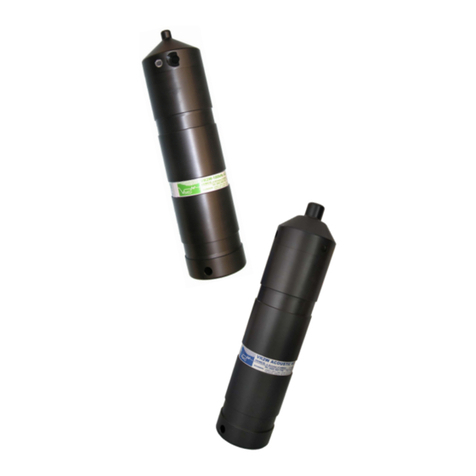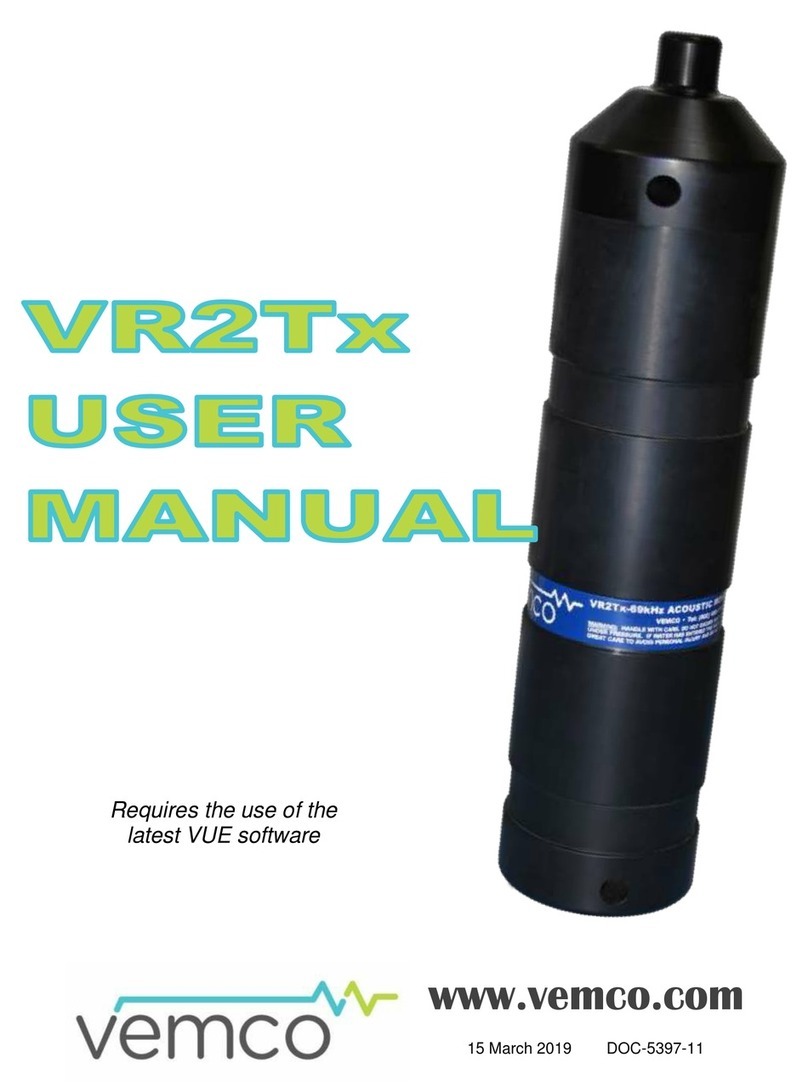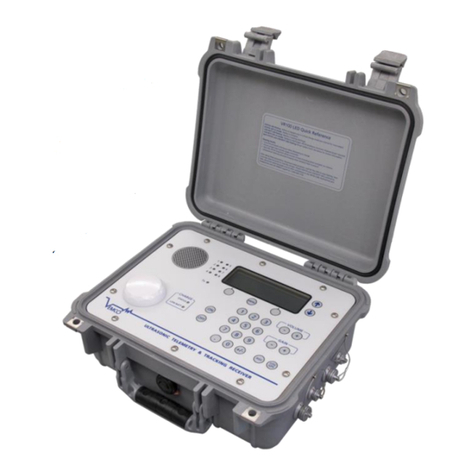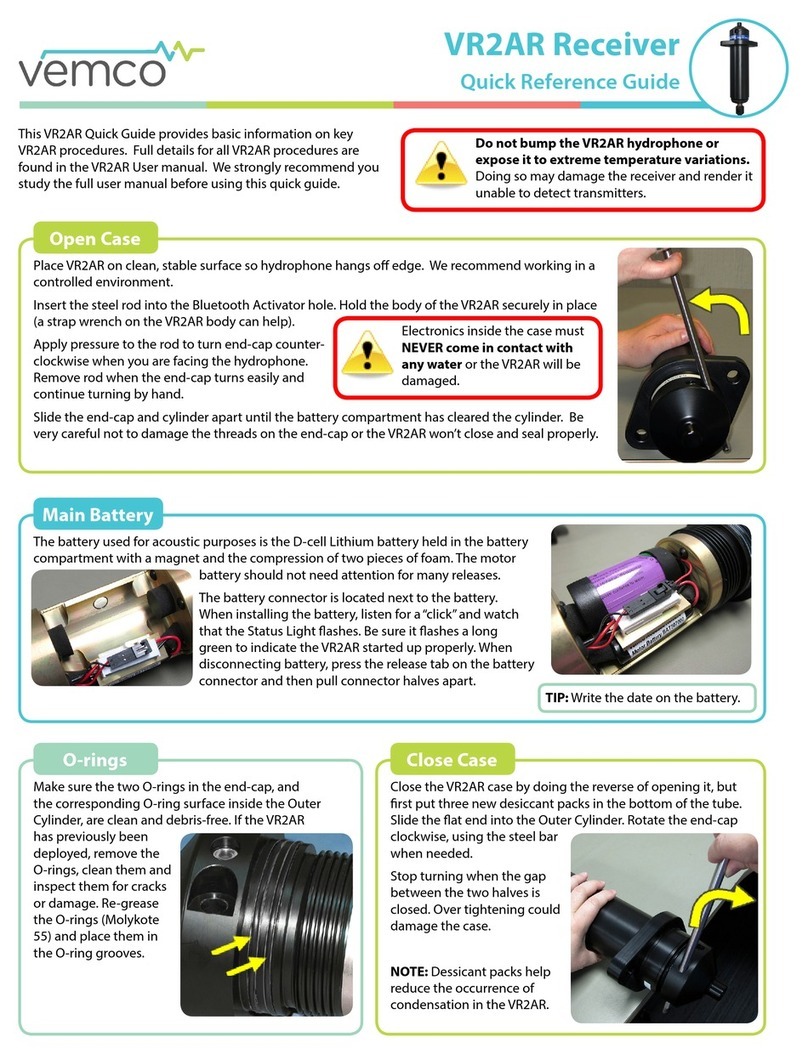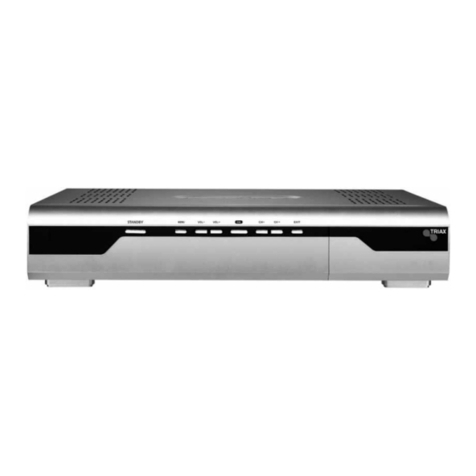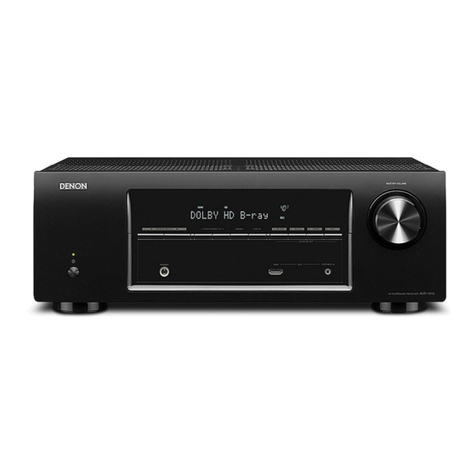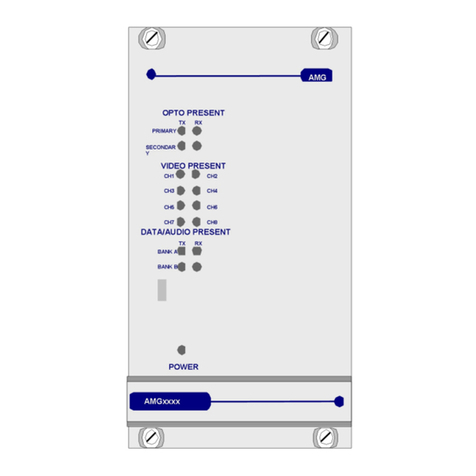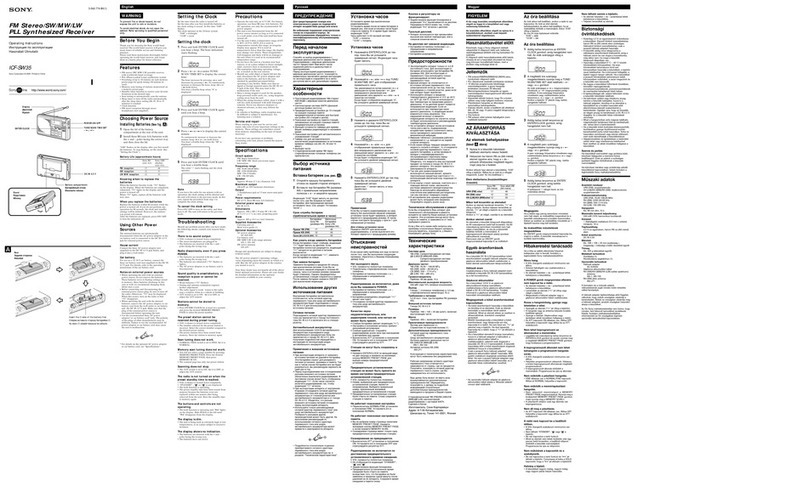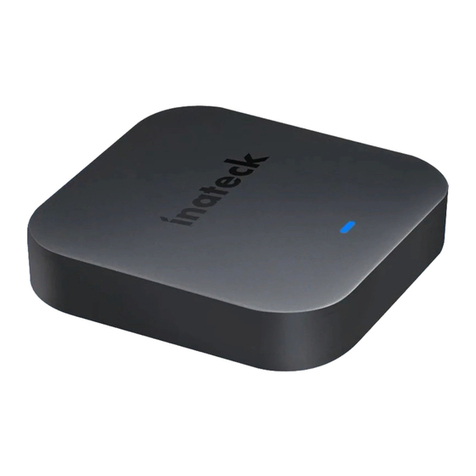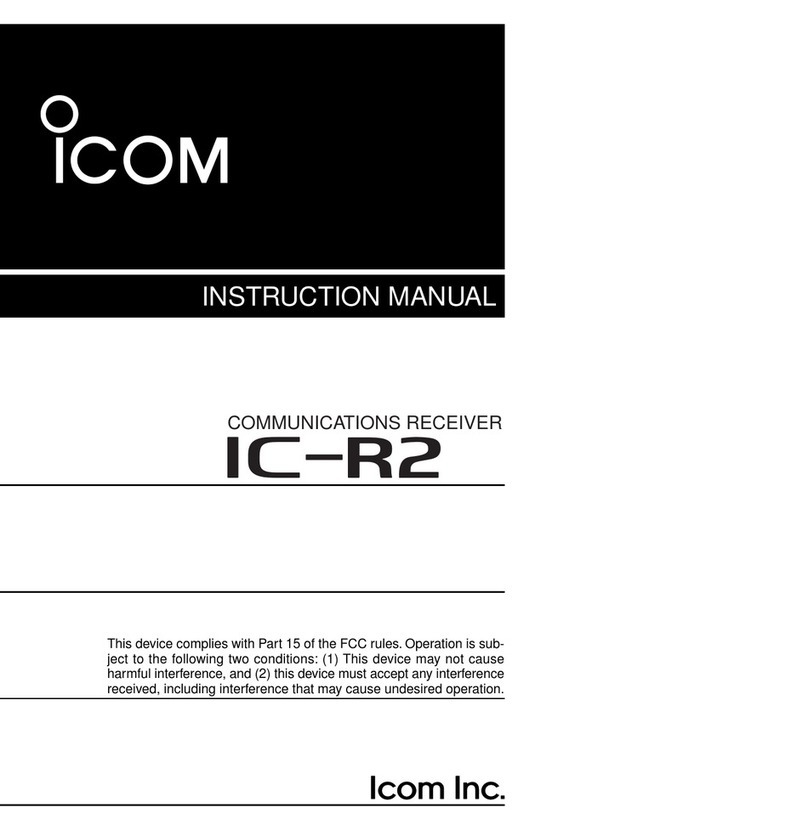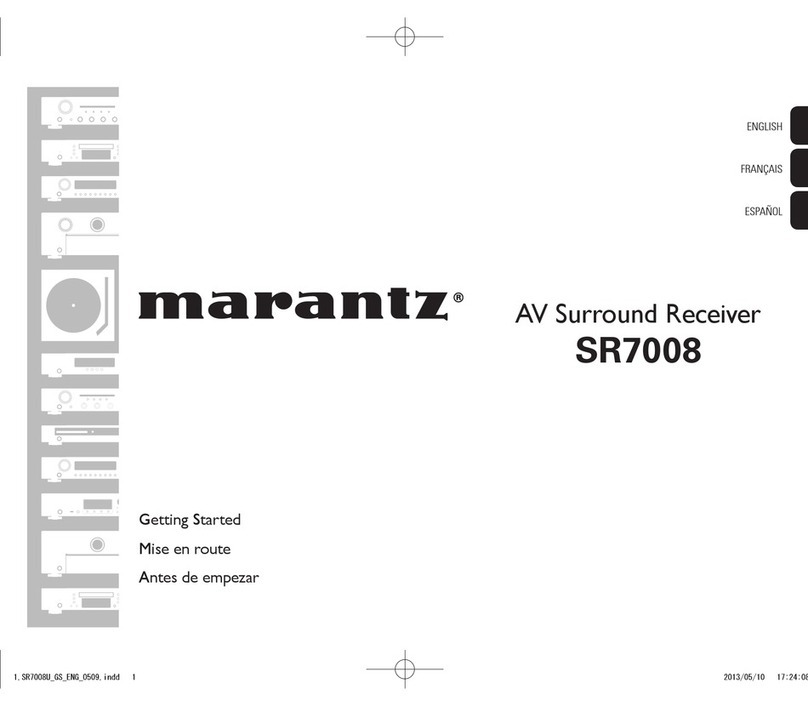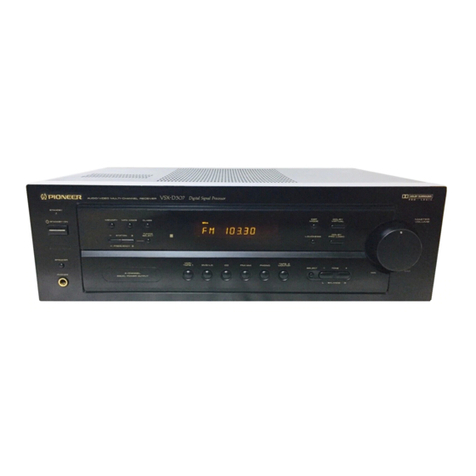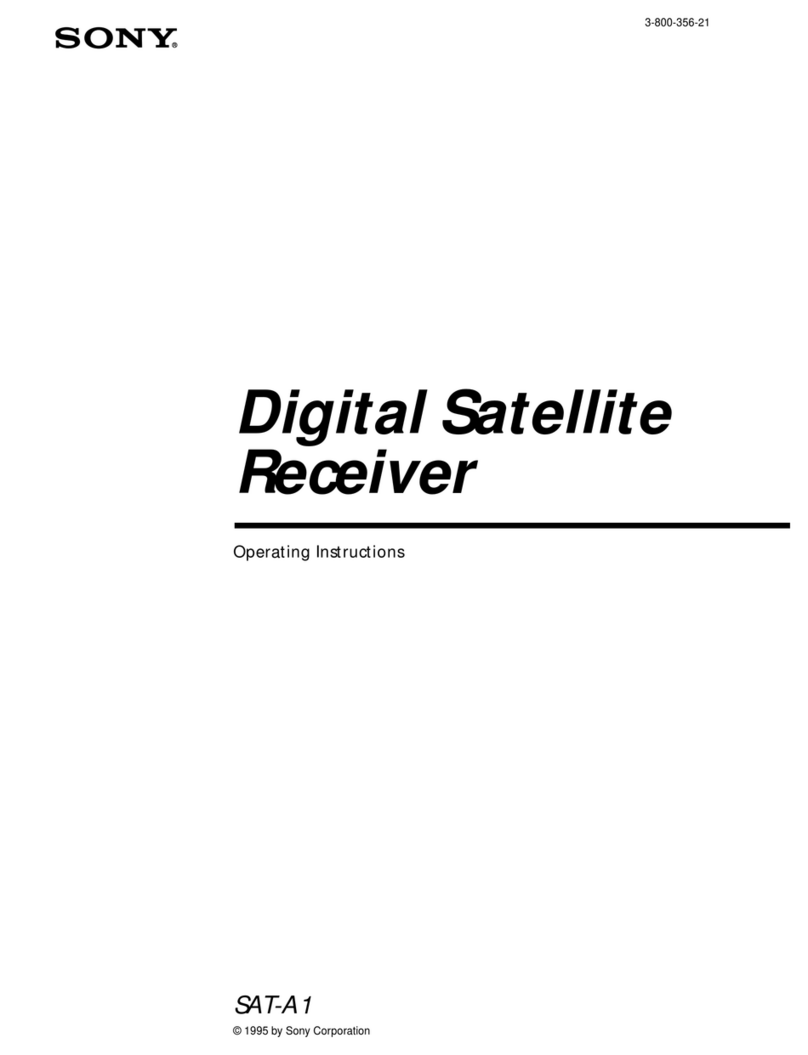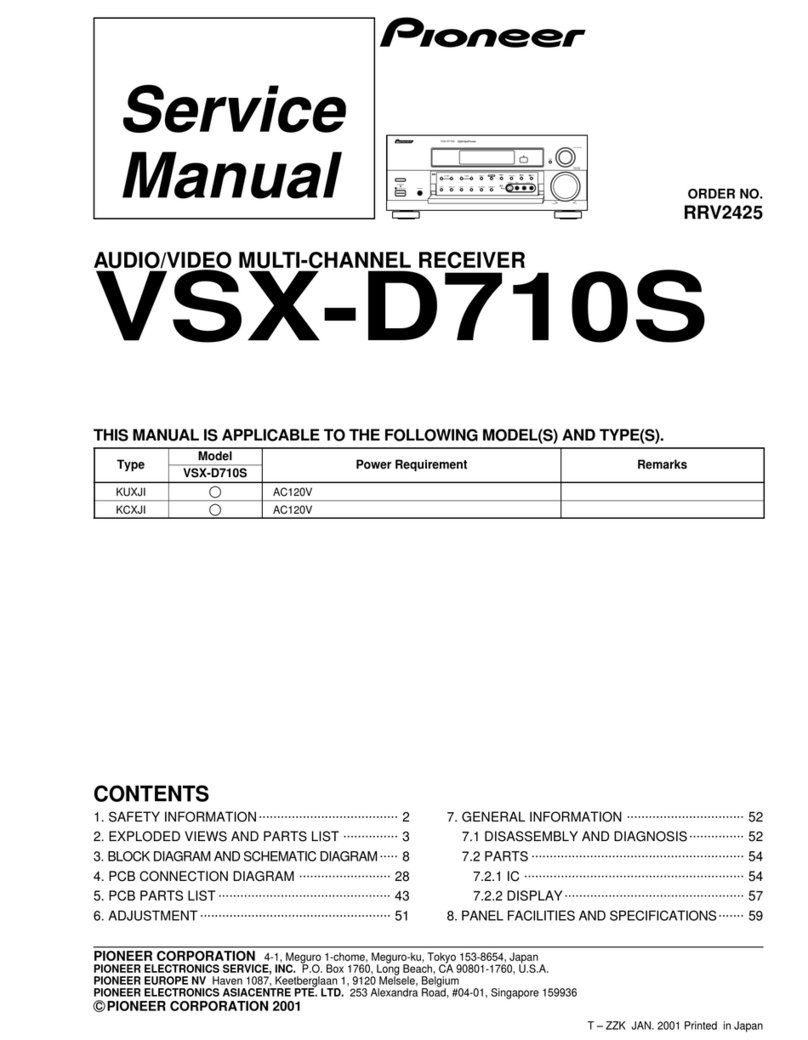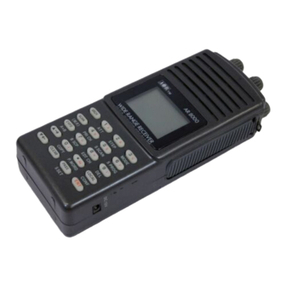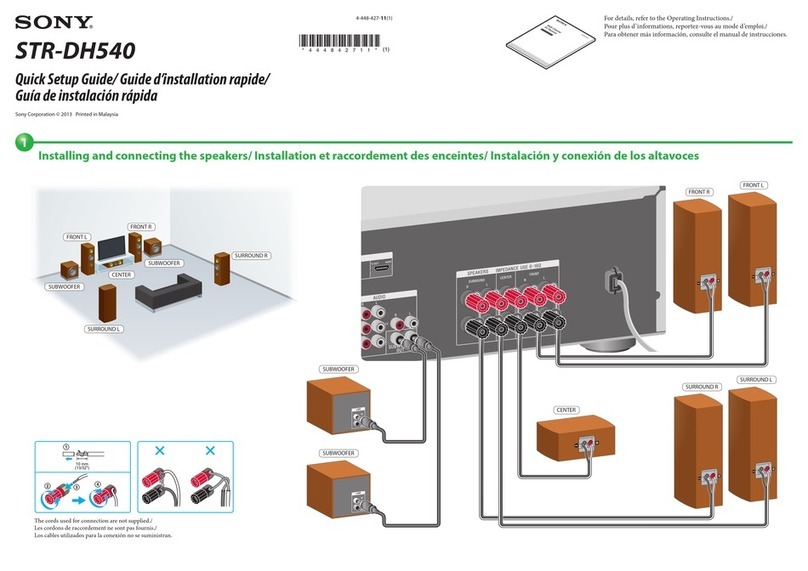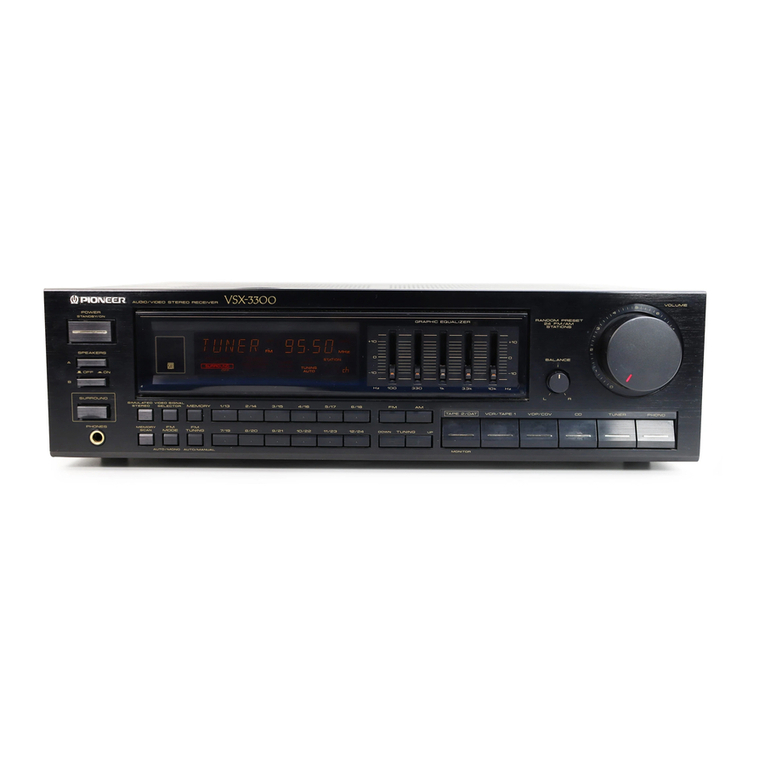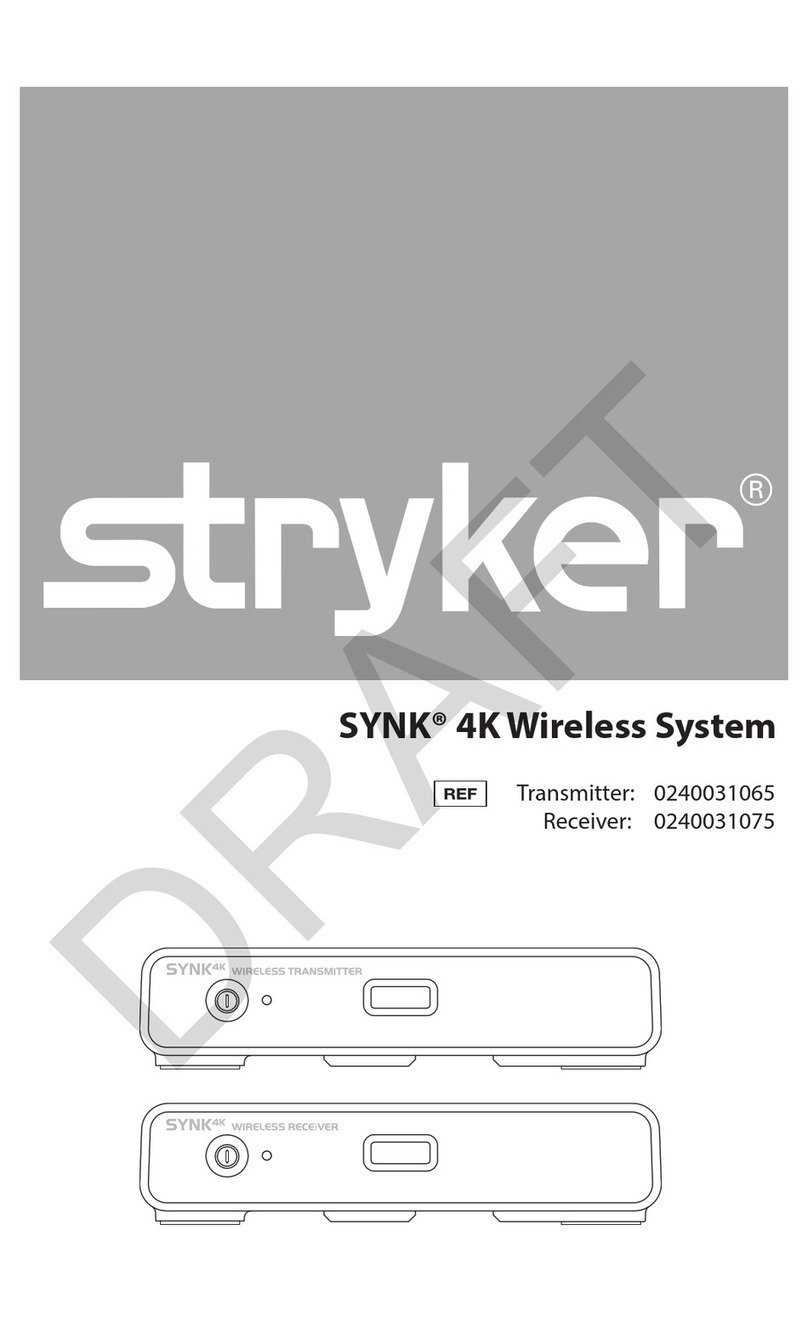Vemco VR60 User manual

VEMCO VR60 RECEIVER
HARDWARE MANUAL
12-12-2011
Copyright © 2011 by VEMCO
A Division of AMIRIX Systems Inc.

AMIRIX Systems Inc.
Warranty and Disclaimer
WARRANTY
AMIRIX Systems Inc., doing business under its trade name VEMCO, provides a one (1) year warranty period for the Product from date of shipment.
VEMCO warrants that on the date of shipment all Products manufactured by VEMCO are free from defects in material and workmanship under normal use and service. This warranty
applies to the components necessary for equipment upgrades, i.e. the VR1/VR2 to VR2W upgrade. With respect to transmitter products, while VEMCO is able to predict battery life
with some certainty, VEMCO cannot guarantee that these Products will remain functional while submerged for extended periods of time. This warranty does not apply to any
equipment, materials or design supplied by Buyer or a third party; re-battery services provided by VEMCO; Products for which VEMCO has not received payment; problems that
results from: external causes such as accident, abuse, misuse; servicing not authorized by VEMCO; usage not in accordance with Product instructions; failure to follow the Product
instructions or failure to perform preventative maintenance; usage of accessories, parts or components not supplied by VEMCO.
This warranty shall survive delivery only on the conditions and subject to the limitations set forth below.
NOTICE PERIODS
To receive a warranty remedy for a Product, Buyer must contact VEMCO’s Customer Support Department during the warranty period to receive the Return Material Authorization
(“RMA”) instructions. Each defective Product returned for warranty remedy must be shipped at the Buyer’s expense according to the RMA instructions and must include reasonable
proof that the claimed defect is due to a matter embraced within the warranty set forth above and that such defect did not result from any act or omission of Buyer, including but not
limited to any failure to operate and maintain the Product in accordance with VEMCO’s applicable written instructions.
REMEDY
VEMCO’s liability, and the Buyer’s exclusive remedy under this warranty, as to a defect in material or workmanship, is limited to the repair of such defect in the accessory, equipment
or part in which the defect appears or, at VEMCO’s option, to the replacement of such accessory, equipment or part with a similar item free from defect. As to any item repaired by
VEMCO or furnished as a replacement by VEMCO, VEMCO’s liability and the Buyer’s exclusive remedy to the repair or replacement of such item for any further defect in material or
workmanship, provided VEMCO receives written notice at Halifax, Nova Scotia, of such further defect from BUYER within ninety (90) days after the repaired or replaced item is
shipped to BUYER and provided that BUYER returns same to VEMCO as provided under “Notice Periods”.
RETURNED ITEMS
All repairs, replacements and corrections described above shall be performed by VEMCO at its plant at Halifax, Nova Scotia, or at such other place as may be mutually agreeable,
and with reasonable care and dispatch in order that the Product, accessory, equipment or part will not be kept out of service longer than necessary. Return to BUYER of a repaired,
replacement, or corrected accessory, equipment, part or Product shall be at VEMCO’s expense. Title to and risk of loss of the Product, accessory, equipment, or part returned to
VEMCO pursuant hereto shall at all times remain with the BUYER, except that title to a returned accessory, equipment, part, or Product shall pass to VEMCO concurrently with
shipment to BUYER of any item furnished by VEMCO to BUYER as a replacement therefore. VEMCO shall have only such responsibility for any Product, accessory, equipment, or
part owned by the BUYER and in the possession of VEMCO as is chargeable by law to a bailee for hire, but shall not be chargeable for loss of use thereof.
WEAR AND TEAR
Normal wear and tear and the need for regular maintenance shall not constitute a defect under this warranty.
DISCLAIMER AND RELEASE
THE WARRANTIES, OBLIGATIONS AND LIABILITIES OF VEMCO AND THE REMEDIES OF BUYER SET FORTH HEREIN ARE EXCLUSIVE AND IN SUBSTITUTION FOR, AND
BUYER HEREBY WAIVES AND RENOUNCES, ALL OTHER WARRANTIES AND OBLIGATIONS OF VEMCO AND ANY ASSIGNEE OF VEMCO AND ALL RIGHTS, CLAIMS AND
REMEDIES OF BUYER AGAINST VEMCO, EXPRESS OR IMPLIED, ARISING BY LAW OR OTHERWISE, WITH RESPECT TO ANY NON-PERFORMANCE OR DEFECT IN THE
PRODUCT OR IN ANY OTHER THING DELIVERED UNDER THIS AGREEMENT, INCLUDING BUT NOT LIMITED TO:
(A) ANY IMPLIED WARRANTY OF MERCHANTABILITY OR FITNESS FOR A PARTICULAR PURPOSE;
(B) ANY IMPLIED WARRANTY ARISING OUT OF COURSE OF PERFORMANCE, COURSE OF DEALING OR USAGE OF TRADE;
(C) ANY OBLIGATION, LIABILITY, CLAIM OR REMEDY IN TORT, WHETHER OR NOT ARISING FROM THE NEGLIGENCE OF VEMCO OR ANY ASSIGNEE OF VEMCO,
ACTUAL OR IMPUTED;
(D) ANY OBLIGATION, LIABILITY, RIGHT, CLAIM, OR REMEDY FOR LOSS OF OR DAMAGE TO THE PRODUCT, FOR LOSS OF USE, REVENUE, OR PROFIT WITH
RESPECT TO THE PRODUCT; OR FOR ANY OTHER DIRECT, INCIDENTAL OR CONSEQUENTIAL DAMAGES; AND
(E) VEMCO MAKES NO REPRESENTATION THAT THE PRODUCT WILL NOT INFRINGE ANY PATENT OR OTHER RIGHTS OFANY PERSON AND BUYER AGREES TO
INDEMNIFY VEMCO AND HOLD VEMCO HARMLESS FROM ANY AND ALL CLAIMS AND LIABILITIES WITH RESPECT TO SAME TOGETHER WITH ANY CLAIMS AND
LIABILITIES WITH RESPECT TO ANY INFRINGEMENT OF ANY PATENT OR OTHER RIGHTS OF ANY PERSON ARISING AS A RESULT OF BUYER'S PRODUCTS,
TECHNOLOGY, ACTIVITIES, OR OTHERWISE.
LICENSE AGREEMENT
VEMCO grants to the Buyer a limited, personal license, with no right to sub-license, to use the Intellectual Property (“IP”) and Embedded Software in the manner set out in the
Documentation. The Embedded Software and IP are not sold to Buyer. All property rights, including Intellectual Property Rights, remain with VEMCO. All rights related to the
Embedded Software not expressly licensed to the Buyer are reserved to VEMCO. BUYER shall not permit any person other than BUYER and its employees to use or make use of the
Embedded Software and/or IP. BUYER shall not, and shall not permit any third party to, modify, adapt, translate, reverse engineer, decompile, disassemble, or create derivative works
based on the Embedded Software and/or IP. This license is assigned to the Product with which you have acquired the Embedded Software and/or IP. If the Product purchased is a
Transmitter product, be advised that the license life is equal to the operational life.
EXPORT
Products and associated materials supplied or licensed hereunder may be subject to various export laws and regulations. It is the responsibility or BUYER to comply with such laws
and regulations.
NEGOTIATED AGREEMENT
It is fully understood by the parties that the price of the Product and other mutual agreements of the parties set forth in this agreement were arrived at in consideration of this warranty,
SPECIFICALLY INCLUDING THE WAIVER, RELEASE AND RENUNCIATION BY BUYER SET FORTH ABOVE (DISCLAIMER AND RELEASE).
© (2011) AMIRIX Systems Inc. All rights reserved. The information contained herein includes information
which is confidential and proprietary to AMIRIX Systems Inc. and may not be used or disclosed without prior
written consent of AMIRIX Systems Inc. DOC-4520-02

TABLE OF CONTENTS
INTRODUCTION ...............................................................1
ABOUTVEMCO ............................................................1
SYSTEMOVERVIEW ........................................................1
HARDWARE ..................................................................2
VR60RECEIVER ............................................................2
PowerSwitchandFuses ....................................................2
ToOpentheVR60Case ....................................................2
GainControl .............................................................2
SignalLevel..............................................................3
ChannelSelection .........................................................3
VolumeControl ...........................................................3
DataOutput ..............................................................3
INSTALLATION ............................................................4
Inspection ...............................................................4
Installation .............................................................4
OPERATION................................................................4
Telemetry Transmitters Application ...........................................4
TrackingandLocatingApplications ...........................................4
AVAILABLE VR60 RECEIVER OPTIONS ..........................................5
DECODER/DISPLAYUNIT (OPTION01) .......................................5
HardwareFeatures(Option01) ...............................................6
Keypad............................................................6
Display............................................................6
SerialPortConfiguration..............................................6
ExternalControl.....................................................7
Low Power Supply Warning ...........................................8
OperationofDecodedDisplay ...............................................8
Decode ..................................................................9
Decode Transmitters .................................................9
DecodePeriod .....................................................10
PulsesperMinute.............................................11
SetFrequency ...........................................................11
Setup ..................................................................12
TimeofDay.......................................................12
Printer............................................................12
LogInterval(Option03B)............................................13
BlankingInterval ...................................................13
Transmitters Setup ..................................................14
Converting Units .............................................17
INTERNAL BATTERY (OPTION 02) ...........................................18
VR60MEMORY (OPTION03B) ..............................................19
MemoryStorageCapacity ..................................................19

LogSetup...............................................................20
Decoding and Logging .....................................................21
RetrieveDatafromMemory ................................................22
ViewData ........................................................23
PrintData.........................................................23
EraseData .......................................................24
DumpData........................................................24
Normal Download of Data (non-compressed) .......................24
BinaryDownloadofData(compressed) ..........................25
Battery Replacement on the Memory Board ..............................26
EXTENDEDCABLE(OPTION04).............................................26
CODED TRANSMITTER (OPTION 07) .........................................27
Transmitter Type .........................................................28
CodedChannels..........................................................29
NON-STANDARD PRESELECTED FREQUENCIES (OPTION 08) ..................30
AVAILABLE SOFTWARE PROGRAMS ...........................................31
SOFTWAREPROGRAMS....................................................31
OPTION COMBINATIONS AND APPLICABLE SOFTWARE ......................32
Setup of VR60 Receiver Software ............................................32
APPENDIX ...................................................................33
GLOSSARY ...............................................................33
LogInterval .............................................................33
PrintInterval ............................................................33
HARDWARESPECIFICATIONS ..............................................34
VR60RECEIVERSPECIFICATIONS........................................34
VH65 OMNIDIRECTIONAL HYDROPHONE (50-80kHz) ......................35
V10 DIRECTIONAL HYDROPHONE (50-80kHz) ..............................36
VH32 OMNIDIRECTIONAL HYDROPHONE (25-35kHz) ......................36
V11 DIRECTIONAL HYDROPHONE (25-35kHz) ..............................37
CODED CHANNELS (order specific) ...........................................38
SYSTEMDIAGRAMS .......................................................39

1
INTRODUCTION
ABOUT VEMCO
VEMCO, a division of AMIRIX Systems Incorporated, is a leader in the design and manufacture of
oceanographic research tools and systems since 1979. Located on the shores of Shad Bay, Nova
Scotia, VEMCO's product line ranges from miniature acoustic transmitters and data loggers to large
tracking, positioning, and monitoring systems. Data communication methods include acoustic
telemetry, radio modem and cellular telephone modem.
Please contact us at:
VEMCO Division Phone: 902-450-1700
AMIRIX Systems Inc. Fax: 902-450-1704
Halifax, Nova Scotia, Web page: www.vemco.com
Canada B3S 0B9
SYSTEM OVERVIEW
The VR60 Ultrasonic receiver is intended to receive underwater signals transmitted from pingers,
location markers, data telemetry transmitters, and other similar devices over a frequency range of 10
kHz to 100 kHz. The VR60 receiver is designed to operate with a hydrophone containing a high
gain, low noise pre-amplifier powered by the receiver. An omnidirectional test hydrophone is
provided as a standard accessory (VH65). An optional V10 or other directional hydrophone, when
used with the signal strength indicator on the receiver front panel, enables the VR60 receiver to
locate and track a transmitter.
An optional Decoder/Display unit (Option 01) provides pulse interval timing and alphanumeric
display of transmitted data, such as depth in meters or temperature in degrees Celsius. A serial RS-
232C compatible interface provides communication to, or control by, a remote terminal or general
purpose computer. The serial interface can also be connected to a printer to log data on paper.
A VR60 receiver equipped with 256K of memory (Option 03B) is capable of saving received data
for later viewing on the receiver or downloading to a computer.
Data from coded transmitters can be received when the VR60 receiver has been equipped with
coded capabilities (Option 07). This allows the receiver to detect a larger number of transmitters on
a single frequency.

2
HARDWARE
VR60 RECEIVER
Power Switch and Fuses
The power switch has four positions, OFF, ON, CHG (Charge) and AUX. The VR60 receiver is
powered with a 12-15 VDC power supply.
If the internal battery (Option 02) is installed in the VR60 receiver, the ON position will power the
receiver from the internal battery. The internal battery receives a float charge if an external power
supply is connected when the power switch is in the ON position (do not connect the external
power with the power switch in the ON position). To charge the internal battery with the receiver
not in operation, move the switch to the CHG (Charge) position as explained in the Internal Battery
(Option 02) section of this manual. The AUX position on the ON switch will power the VR60
receiver from an external power source without float charging the internal battery.
The main system fuse (1 A) is located on the receiver controller circuit board. A fuse (80 mA) for
an independent hydrophone is located on the VR60 receiver’s front panel (top left corner). If fitted
with an internal battery (Option 02), a fuse (1 A) is also located on the charge regulator board.
To Open the VR60 Case
To open the VR60 receiver case, six mounting screws on the front panel and two rubber feet must
be removed. The rubber feet that must be removed are on the same side of the VR60 case as the lid
closure clips, and are the two furthest from the clips. After the six mounting screws and two rubber
feet are removed, slowly pull the VR60 chassis from the case using the two handles. If the internal
battery has been installed (Option 02), be careful of the battery cable while removing the chassis.
Gain Control
The VR60 receiver gain may be controlled automatically by placing the front panel switch in the
AUTO position. When in automatic gain mode, the gain begins at the setting selected on the rotary
switch marked GAIN (dB) at the time the receiver was powered.
For tracking and locating applications, the gain may be manually controlled by placing the front
panel switch in the MANUAL position and using the rotary switch marked GAIN (dB) to set the
gain. The gain may be set in six decibel (6dB) increments, beginning at zero.

3
Signal Level
A signal level meter, located on the front panel, indicates the amplitude of each received pulse.
This indicator is used with the manual gain control and a directional hydrophone for tracking and
locating applications. When the indicator is at full scale, the manual gain should be reduced so
meter variations will indicate transmitter direction as the hydrophone is turned. If the signal level
indicator is at the bottom of the scale, the gain should be increased to detect meter variations.
Channel Selection
The front panel switch labeled CHANNEL controls the preselected frequencies for the receiver. The
eleven preselected frequencies are listed on a plate either on the front panel or on the inside of the
case lid. These frequencies are also listed in the VR60 Receiver Specifications section of the
Appendix. If the receiver has the decoder/display (Option 01), the frequency can also be selected
with the keyboard when the Channel switch is in the external (EXT) position (see Set Frequency
Command).
Volume Control
The front panel control marked VOLUME allows the audio output level (volume) to be adjusted.
The volume increases as the knob is turned clockwise. The volume may be turned down (fully
counterclockwise) during data telemetry applications where audio indications are not required. In
tracking applications the audio level can be used instead of, or in conjunction with, the signal level
indicator to determine when signals are strongest (i.e. when the hydrophone points directly at the
transmitter).
Data Output
A BNC connector on the front panel provides a TTL compatible logic signal (high during pulse
detection) of approximately 150 ms duration. A front panel LED provides a visual indication of
each detected pulse.

4
INSTALLATION
Inspection
Unpack and inspect the equipment as soon as possible. Check that all parts and accessories are
included. Determine if any damage was incurred during shipment and, if so, report to the
transportation company immediately as it is their responsibility.
Installation
Secure the receiver in a dry place and connect the external power cable to a 12VDC power source
(if necessary). Connect the red wire on the power cable to the positive on the power supply and the
black wire to the negative. Deploy the hydrophone (see instructions included with directional
hydrophone, if used), and connect the hydrophone connector to the front panel of the receiver (DO
NOT connect a hydrophone while the receiver is powered).
OPERATION
Telemetry Transmitters Application
Set the rotary gain switch to mid position (36dB) and set the gain switch to AUTO. Select the
correct channel (frequency) for the transmitter to be received, and switch on the power. A short time
should be allowed for the Automatic Gain Control (AGC) to lock on to the transmitter amplitude.
After the AGC is locked on the transmitter amplitude, the front panel LED will flash for each
received pulse. The volume control may be adjusted to a comfortable level without affecting the
signal detection process. If the Decoder/Display unit (Option 01) has been installed in the VR60
receiver, refer to instructions on data telemetry found in the Decode Transmitters section.
Tracking and Locating Applications
Set the gain switch to manual position, and set the rotary switch to mid position (36dB). Select the
appropriate channel (frequency) for the transmitter to be received, and switch on the power. Adjust
the rotary gain switch so the signal level indicator reads approximately mid scale. Rotate the
directional hydrophone slowly past the transmitter direction and observe the increase in the signal
level shown on the signal level meter when the hydrophone is pointing towards the transmitter. The
audio signal also increases as the signal level increases. Either, or both, of these indicators may be
used for the direction to travel in when tracking a transmitter. Make sure that the gain is adjusted
appropriately for best results (see Gain Control section).

5
AVAILABLE VR60 RECEIVER OPTIONS
There are seven options available with the VR60 receiver. These options are listed below, and are
explained in detail in the sections to follow.
Option 01:
Option 02:
Option 03B:
Option 04:
Option 07:
Option 08:
Internal Telemetry Decoder and Display.
Internal rechargeable battery (AC charger module also supplied).
256K CMOS Memory with independent battery backup and data logging
firmware (requires Option 01).
Additional hydrophone cable length available at time of manufacture.
Coded transmitter capability.
Non-standard preselected frequencies in the CHANNEL switch.
It is possible to combine certain options in the same receiver. For example, a VR60 receiver
equipped with Options 01, 02, and 03B has an internal power source and is capable of decoding and
displaying data during a monitoring cycle, while storing the data to memory. Some options are
prerequisites of others, and not all options are compatible with each other. An option with a lower
number is a prerequisite of a higher numbered option, with the exception of Option 02 and Option
04, which may be included in a VR60 receiver regardless of other options. A complete list of
option combinations is available in the Available Software section of this manual.
DECODER/DISPLAY UNIT (OPTION 01)
The Decoder/Display unit (Option 01) is installed in the VR60 receiver case with alphanumeric
display and keypad for data entry and control. A serial communications port on the front panel
allows control and data storage by an external general purpose computer, terminal, or printer.
The primary functions of the Decoder/Display unit (Option 01) are to time the arrival of ultrasonic
pulses, extract any encoded data, and display the information on the LCD display. The time
between pulses (or period) of a pinger is used for identification and is shown on the display in
milliseconds (ms). Telemetry transmitters send information, such as temperature, depth, or speed,
by encoding the data in the time between pulses. A microcomputer within the Decoder/Display unit
(Option 01) uses manually entered calibration data to process the pulses and extract the encoded
data. This calibration data is stored in non-volatile memory (see Setup Decoder section), and is not
lost when the receiver is powered down. Calibration data may be entered for a maximum of twelve
telemetry transmitters, each with up to two multiplexing data channels.

6
Hardware Features (Option 01)
Keypad
The keypad is used to control the functions of the Decoder/Display unit (Option 01) and to enter
data during the setup procedure. Ten digit keys (0 to 9) and a minus sign provide for numeric data
entry. The ENTER/YES key is used to enter the numeric data, or to answer YES to Yes/No (Y/N)
questions. The NEXT/NO key allows cycling through lists of possible identifiers and units during
setup, or to answer NO to Yes/No (Y/N) questions.
The two top right hand keys have dual functions. If pressed directly, the top right hand key (FREQ)
will place the unit in Set Frequency mode (see Set Frequency section). If this key is pressed after
the red shift key, the unit will be placed in the SETUP routine to set the real time clock and
initialize various channel parameters.
The button below this, if directly pressed, will place the unit in DECODE mode for reception of
pulses from the receiver (see Decode section). If this key is pressed after the red shift key, the unit
logs data to an internal memory data storage module inside the VR60 receiver. The LOG function
requires Option 03B. The red shift key is also a plus key (+), used to increment the channel
frequency. The plus key is not used for entering a positive number.
Display
The display is a low power consumption LCD alphanumeric display of two lines, each containing a
maximum of sixteen characters. This display is more clearly viewed from approximately twenty
degrees below horizontal. The optimum viewing angle is factory set by adjusting a trimming
potentiometer on an internal printed circuit board.
Serial Port Configuration
Serial data output is RS232C compatible (Signals: data in, data out, and GND only) and is wired as
Data Communications Equipment (DCE). The 1.5 second delay after <CR> for 300 baud allows
low cost thermal printers to be connected to the receiver. The specifications for each baud rate are
described below:
BAUD RATE 9600 1200 300
CODE ASCII ASCII ASCII
DATA BITS Eight Eight Eight
PARITY None None None
STOP BITS One One Two
END OF LINE <CR> <LF> <CR> <LF> <CR> (no <LF>)
DELAY AFTER <CR> None None 1.5 second

7
External Control
The Decoder/Display unit (Option 01) may be controlled from an external terminal or computer
when connected to the VR60 receiver through a RS232 serial cable. To do so, turn on power and
respond to the “KEYPAD (Y/N)" prompt with NO. The display will then show the default baud
rate of 9600 baud with the Y/N prompt. If this is the desired baud rate then select YES on the
keypad, otherwise select NO until the desired baud rate is shown and then select YES. The baud
rate selections are 9600, 1200, and 300 baud. The display will then show:
ENTER COMMAND
TERMINAL MODE
All future commands may now be entered at the terminal keyboard. The following terminal keys
are used to replace the front panel keypad. To return to keypad operation, the VR60 receiver must
be powered down and powered up again.
EXTERNAL COMMANDS
FUNCTION KEYPAD TERMINAL OPTION
Decode DECODE D
Setup SHIFT SETUP S
Set Frequency FREQ F
Log Data LOG L -03B
Inspect Data Storage SHIFT LOG SETUP LS -03B
Monitor SHIFT 9 +9 or .9 -03B
Enter (YES) ENTER (Y) RETURN or Y
Next (NO) NEXT (N) N
0 - 9 0 - 9 0 - 9
+ + + or . -6
---
. + + or .
NOTE: CTRL-C will reset the VR60 receiver and have the same effect as momentarily switching
off the power.

8
Low Power Supply Warning
Two power safety thresholds are built into the VR60 receiver to ensure the setup parameters (which
are stored in memory) are not altered in the event of a slow power failure. A slow power failure
may occur when the 12 volt power supply gradually falls below 10 volts.
The first threshold contains a warning that the power supply voltage is low. The low voltage
warning is indicated with the appearance of an asterisk "*" in the last position of the second line. In
addition to the asterisk, the ENTER COMMAND display will be replaced by:
ENTER COMMAND
(Power is LOW) *
If the power supply voltage continues to decrease, the VR60 receiver will suddenly stop operating
(second threshold). To restart the VR60 receiver, turn the power switch to off, connect a power
supply with a voltage between 10 - 14.5 volts, and turn the power switch to ON.
Operation of Decoded Display
When using the keypad and display to operate the decoder functions of the VR60 receiver, there are
two types of prompts. These prompts are explained in table below:
(Y/N) The prompt shown on the display should be answered with either a YES or NO. Use
the ENTER/YES key for YES and the NEXT/NO key for NO.
? The prompt shown on the display requires a number (input on the keypad), usually
followed with ENTER.
When the receiver is turned on, the display should read:
VR-60 X.XX YY
KEYPAD (Y/N)
where X.XX is the firmware version and YY is the option code (the version and option code
information should be referred to when ordering further software options). To operate in the keypad
mode, select YES on the keypad. The display should read “ENTER COMMAND”. If NO is
selected at the KEYPAD (Y/N) prompt, the decoder is under external control (see External Control
section).
The possible functions at the ENTER COMMAND level are: Decode (see Decode section), Freq
(see Set Frequency section), Setup (see Setup section), and Inspect Memory (see VR60 Memory
section - Option 03B).

9
Decode
The Decode routine is used for decoding data telemetry transmitters # 1-12 whose calibration data
and frequency have been previously entered during the SETUP routine (see Setup section), or for
showing the raw time periods between incoming pulses. The period option is intended for
identifying simple pingers, or calibrating data telemetry units, and does not support printer outputs
or data logging. The structure for the decode routine is shown below, with a detailed description of
each section to follow:
Decode Transmitters
Before data from a transmitter can be decoded, the calibration parameters must be stored in the
transmitter calibration data setup routine (see Transmitters Setup section). After the calibration data
has been entered, press the DECODE key on the keypad at the ENTER COMMAND prompt. The
display will read:
TR #? (1-12)
(0 for Period)
Enter the transmitter number (1-12) followed by ENTER. The display will show:
DECODING TR# n where nis the transmitter number entered.
If the Channel rotary switch is in the EXT position, the frequency associated with the transmitter
being decoded will appear in the second line. If the Channel switch is not in the EXT position, a
warning will appear on the display. This warning indicates that the desired frequency is being over-
ridden by the frequency set by the Channel switch. The switch must be at the EXT position for the
transmitter to be received and decoded. If a printer is being used, this warning is also printed to
avoid confusion during data analysis. Switching the channel rotary switch to EXT will select the
frequency corresponding to the decoded transmitter and will momentarily show the frequency on
the display.

10
When decoding a transmitter, the VR60 receiver will show “NO SIGNAL” on the display until a
transmitter pulse is received. The LED on the front panel (below display) will flash to indicate that
a signal has been received by the VR60 receiver and is being sent to the decoder. The data from the
transmitter is displayed in the correct units, as assigned in SETUP. For example,
TEMP: 4 "C
DEPTH: 270 m
When decoding multi-channel transmitters, two error messages other than NO SIGNAL are
possible, MISSING PULSE or LOST SYNC. These messages are the result of not receiving either
a data pulse or a synchronization pulse, and are not sent to an attached printer.
The following features are available while decoding a transmitter:
6. The display unit returns to the ENTER COMMAND level by pressing ENTER.
7. The frequency can be changed by pressing the FREQ key (see Set Frequency section). After
changing the frequency the VR60 receiver writes the new frequency to the printer port, and then
resumes decoding.
8. The transmitter number and the time can momentarily be displayed by pressing NEXT.
9. The display will maintain its current value while any digit key is pressed, and will continue once
the key is released.
Decode Period
The Decode Period option is primarily used to identify pingers, but may also be used in the
calibration of telemetry transmitters. To enter the Decode Period option, press the DECODE key at
the ENTER COMMAND prompt. The display reads:
TR #? (1-12)
(0 for Period)
Select the 0 key followed by the ENTER key (or just select ENTER) and the decoder will display
the period in milliseconds (ms). The display will show “NO SIGNAL” until transmitted pulses are
received.
The frequency can be selected with the Channel switch, or with the keypad when the Channel
switch is in the EXT position. There are eleven preset frequency options available on the Channel
switch, which are listed on the inside cover of the receiver. When the frequency is selected with the
rotary switch, only the period is displayed with each pulse (the frequency in not shown). When the
frequency has been selected with the keypad (see Set Frequency section), both the period and the
frequency are displayed with each received pulse.

11
Pulses per Minute
The value of pulses per minute can be shown by using the Decode function. First, setup a
transmitter (see Transmitters Setup section) with the following: frequency (as desired), Rep Rate,
Slope = 60, Intercept = 0, No Decimal. Ignore the ID (Depth, Temp, etc.) and the units (m, ft, etc.)
as neither applies to pulses per minute. Once the transmitter setup is complete, decode the
appropriate transmitter number as described in the Decode Transmitters section.
Set Frequency
The frequency channel can be selected in 100 Hertz (Hz) increments ranging from 10.0 kHz to 99.9
kHz. To do so, position the Channel switch to EXT and press the FREQ key on the keypad. The
display will show the current frequency (69.0kHz in the example below) in the first line. The
second line indicates the choices available: yes, no, increment up, or increment down.
FREQ: 69.0 kHz
(Y/N), UP, DOWN
The response is chosen from the following list:
YES : frequency is OK; exit FREQ routine
NO : change frequency (see below)
+ : increment frequency by 100 Hz
S: decrement frequency by 100Hz
If the response is “No”, the second line of the display requests the input of the new frequency. The
question mark (?) indicates that a numeric entry must be made on the keypad. Enter the first three
digits of the new frequency. For example, if the new frequency is to be 65.5kHz, enter the digits 6 5
5 on the keypad. The new frequency will be shown in the top line of the display and the (Y/N), UP,
DOWN prompt is repeated on the second line.
If the panel switch is not on EXT, the display momentarily warns “FREQUENCY UNDER PANEL
CONTROL”. The frequency is being determined by the switch position rather than the keypad
entry.

12
Setup
The setup routine contains the following features:
1. Set internal time-of-day clock
2. Turn on/off the printer, set the print interval and baud rate.
3. Setup transmitter parameters (frequency, coding type, units, slope, intercept) for up to twelve
transmitters. The transmitter parameters will remain in memory storage until changed.
4. Set logging interval. (Option 03B)
Enter the Setup mode by pressing the Shift key (red plus sign) and the SETUP key (top right corner
of keypad). The routine will then move through the available selections in the following order:
Time of Day, Printer, Log Interval (Option 03B), Blanking Interval, and Transmitters Setup. The
sections of SETUP pertaining to Option 03B is explained in the VR60 Memory section of this
manual.
Time of Day
The display shows the current time in the format days: hours: minutes: seconds (see example
below). The second line in the display shows the Y/N prompt. Select YES if the time shown is
correct, or select NO and follow the prompts to enter the correct time.
3: 8: 25: 16
TIME (Y/N)
The time of day should be reset each time the receiver is turned on if a printer is used, or if data
logging (Option 03B) is employed.
Printer
After the date has been selected, the printer status will be displayed as either:
No Printer (Y/N) or Printer (Y/N)
If there is no printer or storage device connected to the serial port, select YES at the “No Printer
(Y/N)” prompt. If a printed record of the data is desired, select NO at the “No Printer (Y/N)” and
YES at the “Printer (Y/N)” prompt. If a printer is selected, the unit will display the print interval
(time between printing data to the serial port) in seconds. The print interval may be changed by
selecting NO at the (Y/N) prompt and then entering the new interval (between 0 and 100 seconds).
NOTE: When the print interval is zero all data is printed. For example, with a print interval of 10
seconds the data is only printed every 10 seconds.
With a printer selected, the unit will display the current baud rate. Press NEXT until the desired

13
baud rate is displayed (choice of 9600, 1200, or 300 baud). When the appropriate baud rate is
displayed, press the ENTER key on the keypad.
Log Interval (Option 03B)
If data logging is included in the VR60 receiver (see VR60 Memory (Option 03B) section), a prompt
for the Log Interval is shown on the display requesting verification that the Log Interval is correct.
LOG Int. 0 S
(Y/N)
The Log Interval controls the rate at which decoded data is sent to memory. The Log Interval may
be between zero and 30000 seconds (over eight hours) and must be entered as seconds. A Log
Interval of zero will store all the decoded data in memory. For example, if a Log Interval of one
minute is desired, a value of 60 seconds must be entered. The decoded data will be stored to
memory every 60 seconds even though the data may be changing at a faster rate on the display.
If the Log Interval is correct, select YES. To change the Log Interval, select NO and enter the
desired value on the keypad (followed by ENTER).
Blanking Interval
The Blanking Interval is the time after each detected pulse in which echoes and reverberations are
ignored. The Blanking Interval should normally be set to 200 milliseconds. In extremely
reverberant areas the Blanking Interval may be increased but not to exceed 75% of the shortest
transmitter period.
If a Blanking Interval of 200 ms is not desired, select NO a the (Y/N) prompt and enter the desired
Blanking Interval on the keypad (followed by ENTER).

14
Transmitters Setup
The calibration data may be entered for up to twelve telemetry transmitters for use in the Decode
mode (see Decode section). The VR60 receiver is shipped with the calibration data setup for any
transmitters ordered with the receiver. Calibration data for other transmitters may be entered from
the keypad, or with the appropriate software (see Available Software section). If calibration data is
to be changed or added, select NO when the prompt shown below appears on the display. If the
data does not require alteration then select YES.
TRANSMITTERS
SETUP OK (Y/N)
The transmitter calibration data is stored in memory so it needs to be entered only once for a
particular transmitter. The setup of data is explained below in step form.
STEP 1: Select transmitter #
At the prompt “TRANSMITTERS SETUP OK (Y/N)”, select NO. The display will then
show:
SETUP TR#?
(0 TO QUIT)
Enter a transmitter number on the keypad between 1 and 12, followed by ENTER. The
display will then show:
TR n XX.X kHz
FREQ OK (Y/N)
where nrepresents the transmitter number just entered and XX.X represents the frequency.
STEP 2: Select Frequency
If the frequency shown is correct, select YES on the keypad. To change the frequency,
select NO and input the new frequency.
STEP 3: Select decoding type
Press NEXT until the desired decoding type appears. Choose the appropriate type by
selecting ENTER. The existing decoding types are: Interval, Two Channel CAI
(Communication Associates Incorporated), Two Channel Interval, and Rep Rate.

15
STEP 4: Select ID
Press NEXT until the desired ID appears. The existing types are: DEPTH (depth), PRES
(pressure), TEMP (temperature), COND (conductivity), SPD (speed), RATE (pulses per
minute, etc.), and ANGL (angle). When the desired ID is shown on the display, press the
ENTER key.
STEP 5: Select Units
Press NEXT until the desired unit for the ID type appears and then select ENTER. The units
are labels only and do not convert the slope and intercept from one unit to another. For
example, to change the units from meters to feet, the slope and intercept must be converted
and entered in the VR60 receiver as feet. The available Units are shown in the table below:
AVAILABLE UNITS
DEPTH m
ft
fath
meters
feet
fathoms
PRES psi
bars
kg/M
pounds per square inch
bars
kilograms per square meter
TEMP “C
“F °C (degrees Celsius)
°F (degrees Fahrenheit)
COND mmho
Rmilli mhos per centimeter
conductivity Ratio
SPEED mph
knts
m/S
rpm
miles per hour
knots per hour
meters per second
revolutions per minute
RATE ppm
Hz
mSec
pulses per minute
cycles per second
milliseconds
STEP 6: Select Slope and Intercept
The slope and intercept calibrated for each transmitter (listed in the Transmitter
Specifications manual for the order) must be entered. The display will show:
S: XXX I: YYY
T n (Y/N)
where nis the transmitter number, XXX the slope and YYY the intercept. Press YES if the
data shown is correct, or NO to enter the correct slope and intercept. If NO is selected, a
prompt will appear on the display requesting the slope. Enter the slope without the decimal
point and select ENTER. For example, a slope of 25.6 is entered as 2 5 6. The display then

16
prompts for the intercept. An intercept of -256, with the slope above, is entered as - 2 5 6 0.
The choice is then presented to have a decimal point. The display will show either
TR n or TR n
NO DECIMAL (Y/N) DECIMAL Pt. (Y/N)
When NO is chosen, the other prompt is shown. This continues until YES is chosen. Select
the appropriate response depending on the calibration data. If a decimal point is selected,
the slope and intercept are as shown on the left below. If a decimal point is not selected,
then the same input will appear as shown on the right below. The decimal point is usually
used for entering temperature data for display in tenths of a degree.
S: 25.6 I: -256.0 S: 256 I: -2560
T12 (Y/N) T12 (Y/N)
The new slope and intercept are then displayed. If the data is correct, select YES. If the
slope or intercept is not correct, select NO to return to the beginning of Step 6.
STEP 7: Multiple Channels
If the decoding type has multiple channels, Step 4 through Step 6 must be repeated for each
channel. The transmitter has been setup when the display reads:
SETUP TR#?
(0 TO QUIT)
The data can be verified by entering the transmitter number that was just setup. Press the
ENTER key to cycle through the calibration data. A different transmitter can be setup by
entering the new transmitter number and repeating Step 1 through Step 7. To exit the
transmitter setup routine press 0 followed by ENTER, or simply press ENTER.
The setup is completed when the display reads ENTER COMMAND.
Table of contents
Other Vemco Receiver manuals
